Luton Airport Parkway to Harpenden: a walk with Nicholas Faxton.
For a long time, not long ago (from February 2002 to March 2016), I used to wake early. I would leave the house at 6.30 and, by 7.40 approximately, I would be passing through Luton Airport Parkway railway station. In the afternoon, I would leave work early, and, by 5.40 approximately, I would be approaching the same station from the other direction. As I say, I did this every day, five days a week (barring holidays), for a little over fourteen years.
By being in the same place at the same time over such a long period of time (something that would, otherwise, only be experienced by a participant in a scientific experiment, or an art project of some kind), I could observe the landscape changing, in two ways. On the one hand, there were temporal, lateral changes : new buildings were built, old ones demolished, towns sprawled ; crops would rotate in their fields ; supermarkets changed hands, and their neon signs changed with them. Early on, a landfill site was gouged out from a patch of scrubland, festered and flared for some years in the early light, then slowly grassed over, leaving only a scattering of gas-relieving periscopes to warn of the space it had once occupied.
On the other hand, there were cyclical changes : I developed a minutely calibrated sensitivity to the light blooming, then shrinking and contracting again, until, at its lowest point (the Scandinavian months from November to January), the first point in the journey where I could see the outside world more clearly than my own reflection was the landscape immediately beyond Luton Airport Parkway ; it seemed to me unusually beautiful, even the shimmering pools and shining cupolas (or so they appeared in the subdued dawn light) of what was clearly a sewage farm.
Any sight (it is true) would have seemed sweeter to me than, and a relief from, the darkness visible in my reflection, and it is perhaps this, or a simple lack of curiosity, that prevented me from looking into what it was it was that I could see, and why that landscape, with its wooded slopes, its picturesque lakes, and the briefly glimpsed facade of a great house, seemed too good to be true, too true to nature.
About six or seven years into my making this journey, I discovered that the house I could see was called Luton Hoo, and that its grounds, rather than being a happy accident of nature, had been landscaped by Capability Brown. The house itself had been, in the course of several fires, through various iterations, designed first by Robert Adam, then by Robert Smirke. It had been owned by the Earls and Marquesses of Bute, “a Liverpool solicitor” and Sir Julius Wernher, an Edwardian diamond magnate. By the time it had occurred to me to visit the house, which apparently contained an art collection, that was no longer possible, it having been converted into an hotel in 2007.
A little earlier, I had become aware of a path that ran parallel to the railway line, seemingly a rough track. Sometimes there were cyclists, occasionally walkers, whose cloudy exhalations, on cold mornings, mimicked the steam rising from the sewage treatment beds. I could not see where they were travelling to, because the path passed from view as the train put on speed. Shortly after the sewage farm, on the other, left hand, side of the track, I could see a path emerging from under a railway bridge, which led, in the middle distance, to a building which piqued my curiosity. Its purpose was not obvious, and, in its setting, between the sculpted contours of Capability Brown and the homely curves of arable Bedfordshire, it struck me as incongruous and unenglish (something Sicilian, a little Russian), without belonging to any more exotic style of architecture that I could readily identify. Every morning (unless it was raining), I thought how much I should prefer to be walking that path to that building than continuing my journey to London.
Eventually (and you must remember here that the internet was not as informative in those days as it is now), I learned that the path was part of the Lea Valley Walk (which, in its later stages, and in a previous life of mine, I had lived near to and sometimes walked), that it followed the route of the old Luton to Hertford Railway, and that its second leg led from Luton Airport to Harpenden. It took me several more years before I found the time and the inclination to walk it, but have now done so three times, the first time in Autumn, the second in Spring, and the third in the last week of 2016.
Although the route is signposted at the exit to the station, my usual inclination to follow my nose (and my disinclination to walk alongside a dual carriageway) at first led me astray, but, after a few diversions, I emerged from an underpass
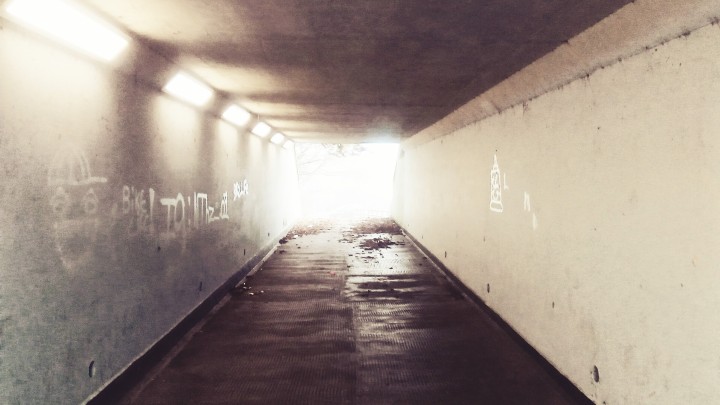
directly underneath a nose-to-tail train of aeroplanes, in the moment that they had burst through to take-off and were accelerating to gain altitude.
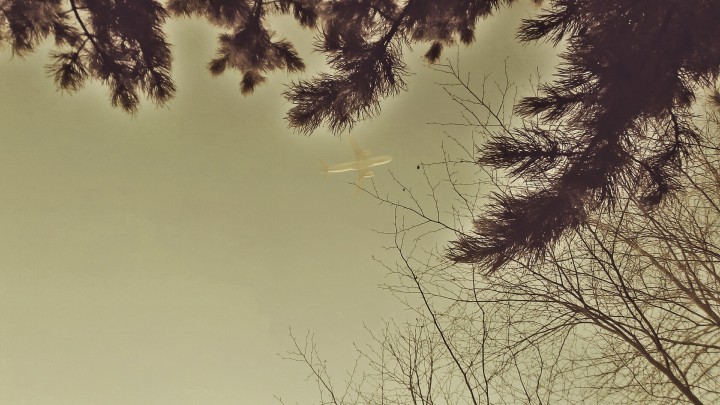
Having been on one of those planes some weeks previously, I felt the closed eyes, aching ears and surreptitious prayers ; I was relieved to be outside, on that path, perhaps the observed and not the observer.
I would say that, of the three seasons, the walk is at its best in Autumn (unfortunately, I appear to have lost the photographs I took of it on that occasion), but, on a clear and frosty morning, I caught it in its Winter best.
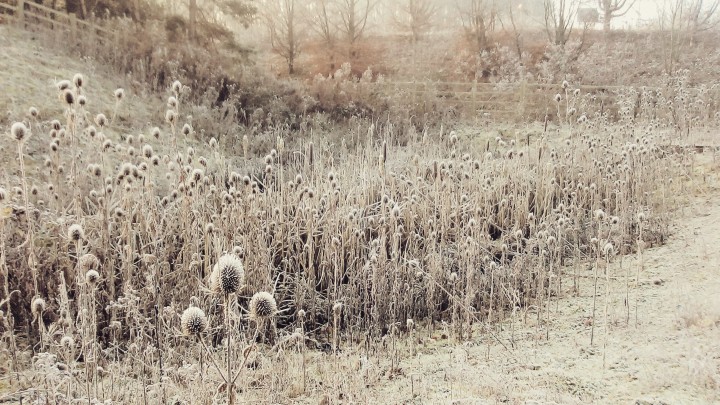

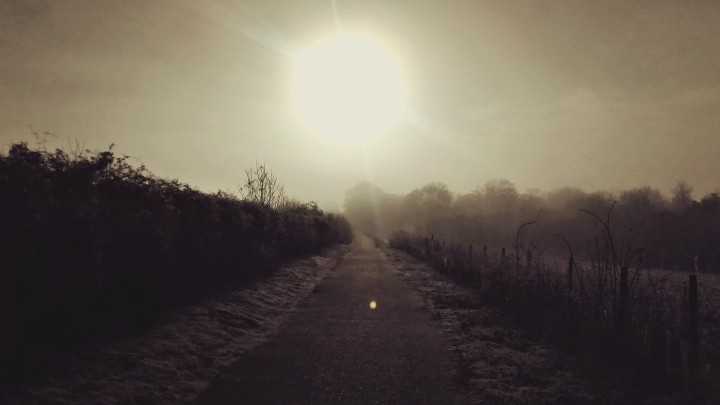

It resembles other paths which once were railway lines, in terms of its flora and occasional fauna, albeit, in its early stages, unusually well-stocked with mature trees (responsible, I suppose, for making its beginnings invisible from the train).
Curiously, by some trick of perspective, or by design, Luton Hoo itself cannot be seen from the path, only its grounds.
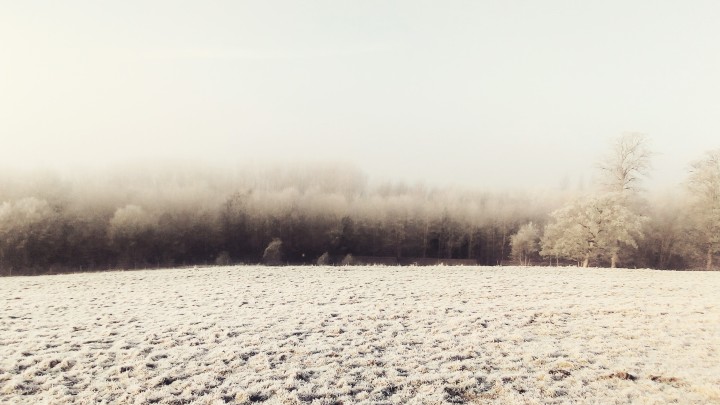
At one point, there is a bench before which three spirits of the Lea Valley loom to obstruct the view.
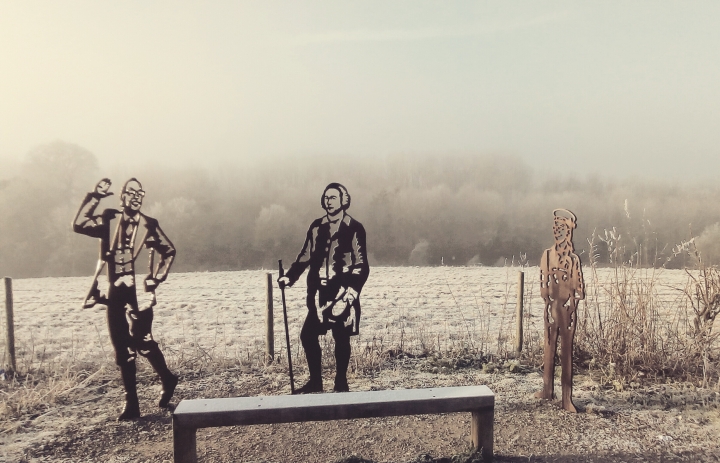
The figure on the left is Eric Morecambe, on the right is the founder of the Luton Sea Scouts (who apparently make use of the artificial lakes of Luton Hoo), and, in the middle, is Capability Brown himself.
For about half an hour the path and the railway proceed side-by-side, until, like two friends falling out on a walk, the path veers away to the right over a viaduct crossing the Lea itself, rounds the sewage farm (which is less attractive than it looks from the train), and, passing under a railway bridge, emerges at the beginning of the road that leads to the incongruous building (the path itself continues on to Harpenden).
The road, which has no footpath beside it, passes over the Lea, which, although the day had started brightly, was half-obscured by fog
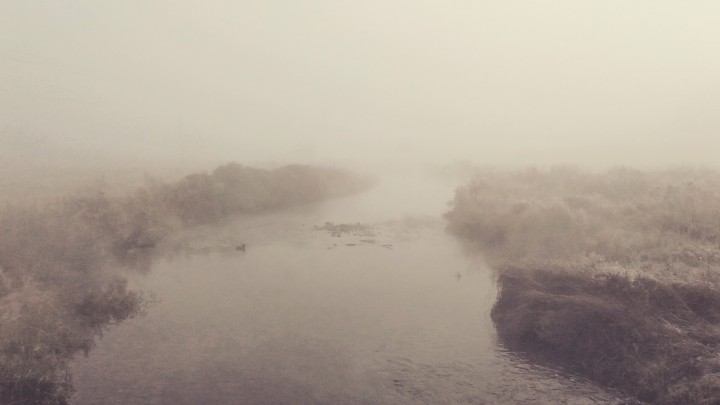
before leading me to what announced itself as St. Charalambos, a Greek Orthodox Church.
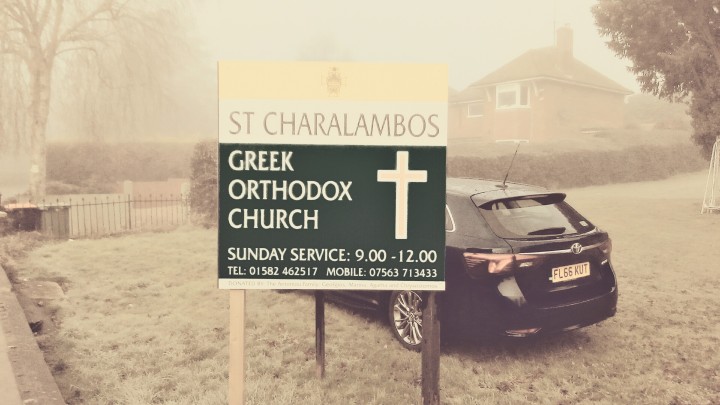
If I had visited when I had first noticed it, I would have found an Anglican Church, dedicated to the Holy Trinity, but that had been abandoned in 2008. Pevsner (I only know this because I have searched the internet) has this to say about it :
“1840-1 by Benjamin Ferrey. Neo-Norman. Facade has 2 large round Norman piers flanking the entrance, and open staircases with Norman colonettes turning left and right. Asymmetrically placed turret.”


The church has a modest churchyard, containing a scattering of small monuments, most of them, apparently, to the inhabitants of the small village of East Hyde, or to those employed, in some way, at Luton Hoo (one of them in the shape of a heart).

The churchyard slopes gently upwards to a precisely-trimmed wall of yew, through which is visible a monument of a type that I associate most with Highgate Cemetery (I lived nearby for some years, and used to stroll there when I had nothing else to do), whose proper name seems to be mausoleum (the word that seems to suit is catafalque, but that is wrong).
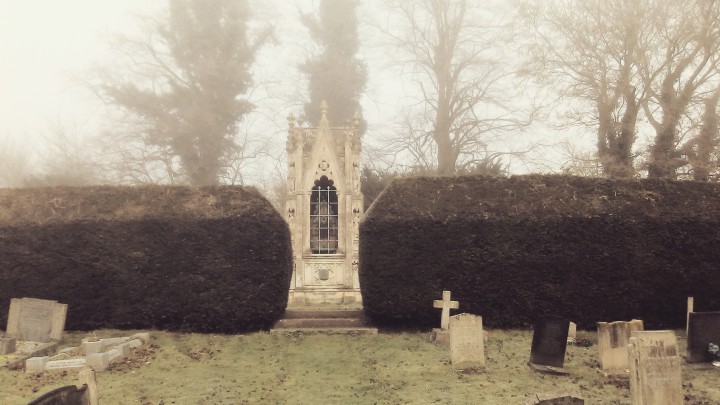
This mausoleum (or catafalque ) belongs to, commemorates, and, presumably (I have never been quite sure of the mechanics of such interments), houses the body of Sir Julius Wernher (as we have seen, the one-time master of Luton Hoo).

The Mausolea and Monuments Trust describes it thus :
“An exceptionally elaborate Gothic Revival monument. The sarcophagus, which is faced with porphiry and supported by six bronze lions, is sheltered by a lavishly carved stone canopy. The quality of both the materials and workmanship is of the very highest order.”
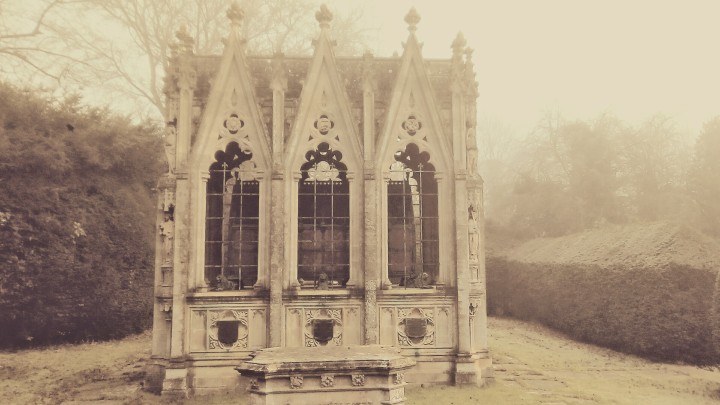
At its corners stand four quasi-angelic figures, each representing what I take to be a virtue (though in some cases, the symbolism is obscure to me).
In addition to Sir Julius himself (whose mortal remains occupy, I imagine, the great lead sarcophagus (faced with porphiry) itself), there are smaller plaques to commemorate his family, as follows:
Alice Sedgwick, Baroness Ludlow, 1862-1945 (his wife)
Lady Zia Wernher, 1892-1977 (his daughter-in-law)
Major-General Sir Harold Wernher, 1895-1978 (his second son)
Derrick Julius Wernher, 2nd baronet, 1889-1948 (his son and heir)
George Michael Alexander Wernher (only son of Sir Harold), died at Reja 4 December 1942 aged 24 and buried in a military cemetery in Tunisia
Alex Pigott Wernher (youngest son), died at Ginchy, France September 10, 1916
One plaque is blank.*
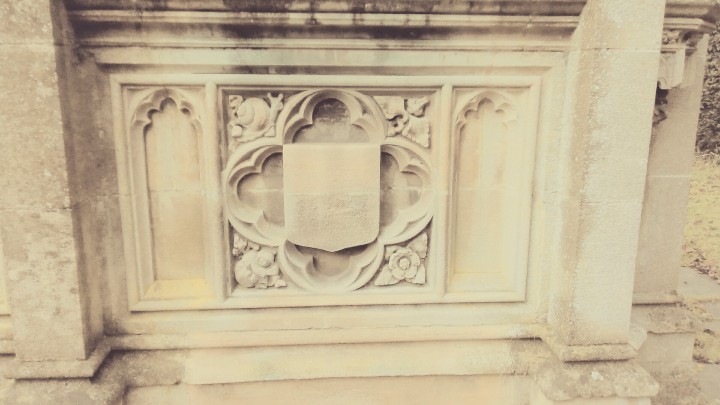
Pharonically, within the enclosure of yew, but apart from the family, there are two smaller monuments, which read :
Harriet Sessions, 12 February 1934, for 39 years faithful housekeeper and friend of Sir Julius and Lady Wernher
Margaret : M. Eleanor Pryce, d. 29 June 1928, lifelong devoted friend of Julius and Lady Wernher
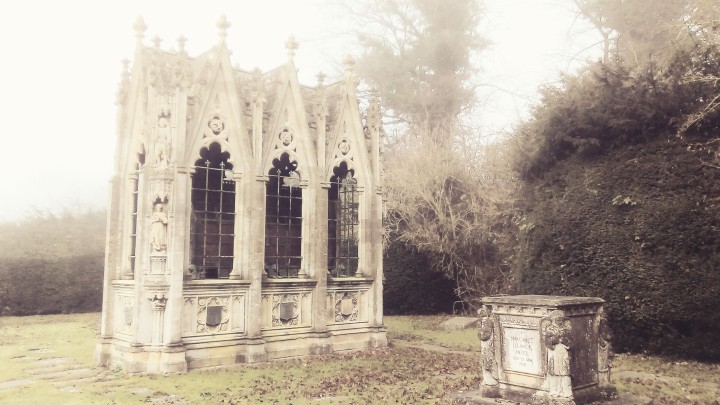
There is also a very small monument, completely obscured by moss, which might have commemorated a dog.
Although, on my first visit, I knew nothing of Sir Julius or his family, I recall feeling that this unexpected enclosure of yew and its porphiry-faced casket, to which I had been drawn, seemed somehow to contain a compressed weight of history, set against the lightness of the English countryside (or, as I wrote in a notebook, rather cheaply “A little corner of an English field that is forever Mitteleuropa“).
By my second visit, I was able to flesh out the bones. I understood the connection with Luton Hoo (which, I learned, had been decorated by the designer of the Ritz Hotel). I knew that Alice, his wife, (nee Mankiewicz) was nicknamed “Birdie”, was painted by Sargent and, after the death of Sir Julius, had remarried a Lord Ludlow. Sir Derrick (the second baronet) had married Theodora Romanoff (an exiled Russian noblewoman, though not related to the Royal Family). Sir Harold’s wife “Zia” was born Countess Anastasia Mikhailovna de Torby, the daughter of an exiled Russian Grand-Duke (and grandson of a Tsar) who owned Kenwood House and was buried in Highgate Cemetery. Tracing the web of family conections (by hopping from one Wikipedia page to another) soon spiralled vertiginously, back to Pushkin and forwards to a handful of Duchesses of Westminster, and other names, too numerous to mention, familiar from the society pages.
I picture Sir Julius selecting the spot where his mausoleum was to be built, fussing about its design, and riding out from Luton Hoo from time to time, (taking, I suppose, much the route I took), to see how the work was progressing (I am assuming it was built while he was alive), and, in time, a sad, grand, procession from the great house when it was time for him to take occupation of his chosen resting place. I picture, too, a succession of other sad processions taking the same route, in due course, to add new bodies (or, if not that, new inscriptions), and others, less sad, but still reflective, a short drive, or a pleasant walk on a Summer’s afternoon away to lay flowers or pay other respects. The mausoleum’s architecture echoes the mediaeval shrines that held relics of the saints, and seems calculated to invite pilgrimage. It is, of course, some time now since any descendant of Sir Julius has occupied Luton Hoo, and the number of those who can remember their occupation of the house, or most of those commemorated by the mausoleum, must be dwindling. I wonder how many, other than me, have found themselves, impelled by some unknown instinct, making what feels as though it is, regardless of its object (I doubt Sir Julius, in life, was quite saintly), a pilgrimage of sorts, and how few of us could describe quite what drew us there, or what it might mean.
* From ‘The Camden New Journal’, 13 May, 2010 “An heiress to a vast diamond fortune who shunned her aristocratic family in favour of a quiet life in Highgate was found dead by a caretaker, an inquest heard.
Anna Wernher, daughter of Sir Derrick Julius Wernher, 2nd Baronet, was found dead in her home in Langbourne Avenue on the Holly Lodge Estate in February. Described as a “recluse,” the inquest heard that she had cut all ties with her family, whose fortune was made by her grandfather Sir Julius Charles Wernher, 1st Baronet, in the diamond mines of South Africa.
Alexander Wills, a close friend of Ms Wernher, said that she complained of feeling “very unwell” when he spoke to her three weeks before she was found.“It was par for the course because she was never feeling very well,” he said. “I didn’t take any particular notice and said to her ‘give me a ring when you’re feeling better and I’ll come and have some tea’.” That was the last time Mr Wills spoke to Ms Wernher, who he described as “suspicious” of medical care.
It is believed Ms Wernher will be buried in the family mausoleum in East Hyde, Bedfordshire.”
******************
After leaving the churchyard, I retraced my steps and rejoined the path that led to Harpenden, where I enjoyed a toasted bruschetta and a cup of caffe latte, before taking the train home, passing back through Luton Airport at about, I suppose, 3.40.
Time taken : 2 hours approximately.
Degree of difficulty : very slight.




Reblogged this on The New Crimson Rambler and commented:
The first post on the new blog. Warning : contains no cricket at all.
LikeLike